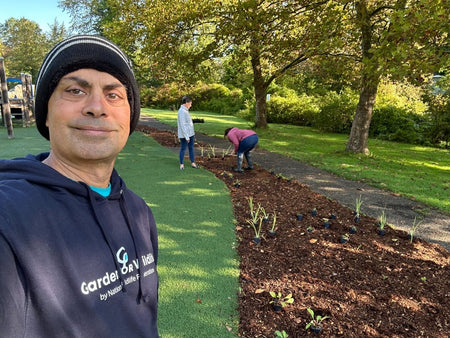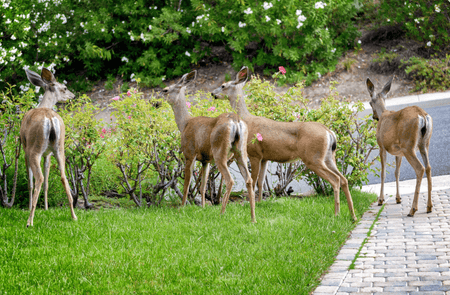Why HOAs Should Encourage Wildlife Gardening in Neighborhoods


Nationwide, millions of people live in communities governed by HOAs. Traditionally—and still the norm today—such communities enforce conventional landscape aesthetics, namely turf grass and other nonnative plants that do not support biodiversity and require chemical fertilizers and pesticides. Lawns make up one-third of the country’s 135 million acres of residential landscaping, according to the ecologist Douglas W. Tallamy, who calls the velvety carpeting of bluegrass or ryegrass “ecological dead zones.”
Yet in recent years, little by little across the country, restrictions on wildlife-friendly yards have begun to adapt to more modern, sustainable thinking. Sometimes, it is enlightened members of HOA boards who make the changes. More often, members of the community work to update rules. It’s important to research and understand your neighborhood, local and state laws to ensure you’re fully equipped to fight the good fight.
The National Wildlife Federation published a must-read Guide to Passing Wildlife-Friendly Property Maintenance Ordinances, which provides model ordinances as well as landscape plans. This guide is for mayors, heads of local and tribal governments, municipal staff, homeowners’ associations, and others who want to promote the expansion of wildlife-friendly habitats in their communities. It provides case studies of cities that revised their property maintenance ordinances to incentivize homeowners and other landowners to transform their land into wildlife habitats.
Why update Homeowners Association landscape rules?

Transitioning a neighborhood to include more native plants offers numerous benefits, both for the environment and the community. Here are some key advantages:
- Biodiversity conservation: Native plants have evolved and adapted to local ecosystems over centuries, providing essential habitat and food sources for native wildlife, including birds, insects, and other animals. By incorporating more native plants, neighborhoods can help preserve and support local biodiversity, contributing to a healthier ecosystem.
- Water conservation: Native plants are typically well-suited to the local climate and require less water once established. Their deep root systems help improve soil structure and water infiltration, reducing the need for irrigation. By choosing native plants, neighborhoods can reduce water consumption and promote sustainable water management.
- Reduced pesticide use: Native plants have developed natural defenses against pests and diseases, making them more resistant and resilient. This reduces the need for chemical pesticides and fertilizers, leading to a healthier and more environmentally friendly neighborhood.
- Improved air quality: Native plants play a crucial role in improving air quality by absorbing pollutants, such as carbon dioxide, nitrogen dioxide, and particulate matter. They also release oxygen through photosynthesis, contributing to cleaner and fresher air.
- Erosion control and soil health: Native plants' extensive root systems help stabilize the soil, preventing erosion and runoff. They also enhance soil health by improving its structure, nutrient cycling, and water-holding capacity. This, in turn, supports healthier plant growth and reduces soil erosion risks.
- Aesthetics and sense of place: Native plants often reflect the unique beauty and character of a region. By incorporating them into neighborhood landscapes, residents can create a distinct sense of place, enhancing the overall aesthetics and cultural identity of the area.
- Lower maintenance requirements: Once established, native plants generally require less maintenance compared to non-native species. They are adapted to local conditions and can withstand local climate fluctuations, reducing the need for extensive watering, pruning, and fertilization.
- Education and community engagement: Transitioning to more native plants provides an opportunity for community engagement and education. Neighborhoods can organize workshops, plant sales, or nature walks to raise awareness about the importance of native plants, conservation, and environmental stewardship. This can foster a sense of pride and ownership among residents, promoting a stronger and more connected community.
How To Challenge Homeowners Association’s Landscape Laws

Convincing a homeowners association (HOA) or local government to allow for wildflower native plant gardening can be challenging, but there are several strategies that you can use to make your case:
- Educate the HOA: One of the most important steps is to educate the HOA about the benefits of native plant gardening (more on that below!). You can provide information about how native plants can improve the local ecosystem, provide habitat for wildlife, and reduce water usage.
- Provide examples: Show the HOA examples of successful native plant gardens in other communities. You can share photos, articles, and even invite members to visit other neighborhoods to see the benefits of native plant gardening first-hand.
- Address concerns: Address any concerns the HOA may have, such as the fear that wildflower gardens may look messy or attract pests. You can explain how a well-designed native plant garden can be both beautiful and low-maintenance, and how the plants can attract beneficial insects and birds.
- Work with the HOA: Work with the HOA to develop guidelines for native plant gardening that are acceptable to all parties. For example, you may agree to use certain plant species, maintain a certain level of maintenance, or avoid certain areas of the community.
- Start small: Consider starting with a small pilot project or demonstration garden to show the benefits of native plant gardening. This can help to build support and demonstrate that the garden can be both attractive and functional.
- Garner support: Build support among community members by sharing information about the benefits of native plant gardening and the positive impact it can have on the community. You can use social media, flyers, and community meetings to spread the word and encourage others to get involved.
Convincing any naysayer requires persistence, education, and a willingness to work with the community. By addressing concerns and building support, you can help to create a more sustainable and wildlife-friendly community which benefits all of its inhabitants, wild or not.
HOA-Approved & Wildlife-Friendly Wins
From National Wildlife Magazine: YEARS AGO, when Janet Crouch planted a pollinator garden in her Columbia, Maryland, front yard, she had no idea she’d have to fight her homeowners association (HOA) in order to keep it. Today, her coneflowers, goldenrods, butterfly weeds and black-eyed Susans are finally safe from threats of obliteration by her HOA—and thanks to Crouch’s efforts, other state residents living in HOA-governed communities can feel free to nurture wildlife habitat on their property as well.
In 2017, “we decided to fight when we started getting nasty letters from HOA-hired attorneys telling us to remove our pollinator garden,” says Crouch. After a long legal struggle, Crouch and her husband came to a settlement with the HOA on December 31, 2020, in a pretrial agreement allowing them to keep their bird and butterfly haven.
Janet also contacted her state delegate, Terri Hill, for help. In 2021, Hill sponsored a bill giving homeowners new rights over landscaping choices in their yards. The bill passed both the Maryland Senate and House and became law on October 1. Now, HOAs throughout the state must permit “low-impact landscaping,” which includes growing native plants, xeriscaping and installing rain gardens. Maryland became the first state to limit homeowner control over eco-friendly yards.
In May 2023, the Maine state Legislature’s Judiciary Committee voted in favor of a bill from Sen. Mattie Daughtry, D-Brunswick, to promote native plants in landscaping, while supporting the rights of homeowners. LD 649, “An Act to Promote Water Conservation and Water Quality and Create Habitat for Wildlife, Including Pollinator Species, by Protecting Low-impact Landscaping.” LD 649 would prohibit condo associations and homeowner associations from restricting landscaping techniques that conserve water, lower maintenance costs, provide pollution prevention and create habitat for wildlife. This would apply to any proposed restrictions put in place after Jan. 1, 2024.
In Florida, some homeowners have had success fighting HOAs based on an older law which allows for “Florida-friendly landscaping.” The goals of this legislation are conserving water, preserving natural resources and reducing water pollution. A great start!
According to FloridaBar.org, based on the “right plant, right place” component of F.S. §373.185 (the older law), one could argue native plants are protected and an HOA cannot prohibit a homeowner from selecting native plants for his or her landscape. However, whether a homeowner can select ANY native plant remains an open question because it does not specifically state native plants are protected. This is an opportunity for the state to do the right thing and provide protection for native plants.
In Virginia, there’s plenty of examples pointing in the right direction of protecting our pollinators, plants and other wildlife.
It’s important to research and understand your neighborhood, local and state laws to ensure you’re fully equipped to fight the good fight, but these examples can inspire and encourage us all to push for more sustainable solutions that benefit people, wildlife and the environment.
Creating a Certified Wildlife Habitat® Community
No need to stop with just changing the local laws! The National Wildlife Federation's Community Wildlife Habitat™ program partners with cities, towns, counties, neighborhoods, and communities of all kinds to become healthier, greener, and more wildlife-friendly. Community Wildlife Habitats garden and landscape with wildlife in mind, promote the use of native trees and plants, work to reduce or eliminate the use of pesticides and chemicals, and integrate wildlife-friendly practices into sustainability plans and park master plans. Through this program your communities can enhance and restore islands and corridors of wildlife habitat in urban and suburban areas nationwide, while at the same time connecting to existing work around climate resiliency, community resiliency, urban forestry, water conservation, beautification, and more.
Community Wildlife Habitat program allows communities to customize or emphasize local priorities. Some communities focus on water conservation measures by installing rain gardens to prevent storm water runoff. Others focus on creating wildlife corridors by connecting existing green spaces to new Certified Wildlife Habitats. Still others use the program to engage citizens around the importance of using drought-resistant native plants or reducing the use of pesticides and chemicals.
Read the guide to becoming a National Wildlife Federation Community Wildlife Habitat™.


Find Native Plants by Zip Code
We took the guesswork out of planting native. Check your zip to see what ships!


















